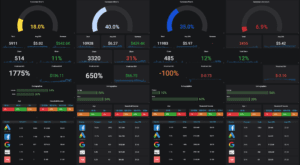Creating Personas and Communications to Match the Customer Experience
I was recently looking for a Project Management solution and tested out about 10 different solutions. Earlier in my career I was a professional project manager (and I’ve set up and used dozens of different project management solutions throughout my career) so I’m a very educated user.
Project Management software is a highly competitive market. There are hundreds of solutions available, most of which have ridiculously similar features – create tasks, assign dates, assign resources, and track status. It’s not rocket science but PM software companies like to pretend that it is.
It’s amazing to me that companies in highly competitive industries don’t create power user personas and don’t follow-up later to see if the customer is using a competitive product.
Project Management generally has four different personas:
Educated PMP-Certified Users (the Power Users): These users generally have enterprise experience, have managed many projects and used many tools. They’ve followed formal and informal processes for completing project work. (I’d group myself in this category – I got my PMP certification in 2006 while working at a Fortune 50 company.)
Project Coordinators: These users are tasked with ensuring task completion, but not necessarily all the political or technical nuances for project delivery. Often marketing teams have a project coordinator who is responsible for ensuring different teams are working together – for example, ensuring that copy writers get their content reviewed by the SEO team.
Technical Project Lead: These are the users that are leading a project but don’t have a PM/Project Coordinator title. They tend to be either very technically focused (i.e. a lead engineer on a software or hardware project.) A technical project lead’s main priority is shoring up estimates and tracking status. Their educational opportunity is centered around managing change requests. Uneducated leads will often try to hit their dates while also adding in major feature changes. Educated PMs identify if there’s a schedule impact and negotiate for more time or resources.
Functional Project Lead: These resources are very functionally focused for creating business process changes. Often with a functional project, the priority is communication and training. Their educational opportunity is around
Each of these users has a specific need.
Title | PM Experience | Need |
PM | High | Get up to speed quickly – how to create a project, assign tasks to users, set up dependencies, track issues, and create status reports. |
Coordinator | Medium | Assigning tasks and tracking completion. Learning best practices for managing cross-functional projects. |
Lead (Technical) | Low | Assigning tasks, tracking completion and ensuring estimates are accurate. Learn about tracking change requests, tracking issues, and improving delivery timelines. |
Lead (Functional) | Low | Assigning tasks, tracking completion and ensuring communication plans are executed, training is created and delivered, and that the business process change is achieving the expected result. Learn about managing political issues and best practices for business process re-engineering. |
Most of these companies had an onboarding drip email campaign (which I immediately unsubscribed from – I’m a power user!), and one of them had a person who kept harassing me to meet which I had to respond to. It was a very frustrating experience because had they looked at my LinkedIN profile, they would have seen that I was a professional project manager in 2006-2008 and that I’ve led hundreds of projects throughout my career. After the 3rd email from them two days in a row, I finally replied to them:
“I’ve been managing projects for about 15 years and have used dozens of project management tools. I’ve set up at least 3 PM tools in the past 4 months – nothing I’ve loved. Hoping to love yours.”
Here was their response:
“Hi Crystal,
Thank you for the note. Below are links to a webinar and getting started videos that are very helpful for an evaluation of <software>.
If you have any questions or I can help in any way please don't hesitate to reach out.”
Then they sent me some generic links that didn’t actually address my needs, including articles such as how to add users. (No offense, but if I have to spend more than 2 minutes figuring out how to add users to your software you are doing it wrong.)
I am clearly a power user but they sent me the basics. If I’ve set up 3 solutions and used dozens of tools then the communication (which came from a PERSON) should have focused on how to quickly get me up to speed and why their solution is superior to their competitors.
I reviewed the links they provided and this company doesn’t track if I looked at their email nor clicked any of their links. Basically, this entire conversation was a waste of everyone’s time – theirs for sending it, mine for reading it.
Now then the second part of the problem with this company. If I’m signing up for a free trial and then cancel, it’s very likely that I have a need for a solution that was probably served by a competitor product. A few weeks after I canceled, they should have sent an email asking what product I ended up using and why.
In three sentences I could have told them why I chose another company over their solution:
Their Slack integration (specifically why I chose their product) didn’t work the way that I hoped. It was complex and noisy.
Their app was very complex. It took multiple steps to complete tasks and had some usability issues.
The product I chose was simpler and more visual for tracking project status.
Question #1 Do you think I’m the only one of their customers who went to a competitive product? (Unlikely - particularly in this space.)
Question #2 Do you think that with this level of information that all of their teams could be more effective? Could they build a better product and could they identify people who churn for the same reasons?
Question #3 Could they gain insights on what customers want and need and learn more about their competitors?
What Went Wrong
Personalization isn’t very hard. In this scenario, asking 3 questions would have quickly identified the customer persona. What level of experience do you have with PM systems? What types of projects are you managing? What are your top 3 priorities for your decision?
From this info, it’s easy to create content tailored to their specific needs and dramatically improve the customer experience and conversion percentages.
You only capture the information you ask for. If you never ask then you are making guesses as to why people churn. Granted, it’s hard to get people to respond (or even open an email today), but with some incentives and an easy communication method (i.e. a 1- or 2-question survey), enough people should respond that gives you better information on churn than ‘guessing’.
You spent a lot to acquire that customer - a lot in terms of marketing effort and even perhaps in ad spend. Shouldn’t you know what they are looking for?
Creating a Personalized Customer Journey
Creating a personalized journey is it's own journey. What if instead of dripping everyone, we looked at the data instead to understand customer behavior?
Ask Questions During Onboarding
There are a handful of questions that you can ask during the onboarding process that can help you significantly improve the process. Have they used a competitive product? What's their level of experience? What are their initial thoughts?
Observe the Data
All customer behavior can be tracked. Even lack of behavior is a metric. Are they opening your emails? Did they log into the system? What did they do? Did they get an error? How long were they on a specific page vs. other customers?
Segment and Semi-Personalize
Segment your customers into their archetypes. Are they tech-savvy or not? What's their level of experience? How would you support someone on Day 1 vs. Day 30 vs. Day 120? What are power users doing on Day 120 that regular users aren't doing? This can be a great indicator of churn risk.
Hyper-Personalize
Identify the person - who they are and what they like/don't like. What are the features people are/are not using? Then identify what they want and need. What do they need that they don't even know about? What are all the features that they could use that they should be learning about? All of these areas are ways to differentiate and deepen the relationship with the customer. These are the areas that should be personalized.
Create Touchpoints
Make it super-easy to provide feedback along the way. A quick 1-minute survey can create a treasure trove of information that can be tracked over time and included in KPIs metrics. (See our article on why KPIs create great marketers.) This type of information can evolve your organization to a data driven organization.
Offboard Well
Offboarding is a great way to learn about your competitors and what they are doing better than you. What features were missing? Why was their solution better? What could you do better? What recommendations do you have? Why did they choose you? What need was promised that wasn't fulfilled? What did they think about the level of communication? Too much, not enough? Asking a few targeted questions can dramatically improve the experience and lead to greater retention rates.
Aggregate and Correlate
Having information is great, but it's not useful unless someone is looking at it. Too many companies create surveys that are never reviewed. Too many companies never follow-up. The data is only useful if it's being leveraged to make business decisions. Product roadmaps should be planned based on data from the masses, not feedback from a small group of power users - which is how most companies do it. By tracking these data points over time, you can see if your product is getting better or worse and how the customer journey is evolving over time.
Getting Started
Admittedly, all these data points are hard to capture and hard to aggregate. It's scattered across different systems and is hard to access. However, you don't have to boil the ocean to make some huge leaps forward.
The quickest and easiest way to win is with the onboarding and offboarding questions. Asking very simple and targeted questions when onboarding creates a context for your customer types. Then with offboarding you can compare notes – what did they expect when they onboarded and why didn't we meet their needs when they offboarded.
Leveraging these two processes alone can drive true efficiencies in marketing and customer service that take your company from lame drip campaigns to truly responding to customer needs.








